Chanterelle
This very tasty mushroom can be found in small groups in woodland, more often with beech or birch. A delight to come across, but be careful of other foragers as they can be quite territorial over their Chanterelle patches!
| Mushroom Type | |
| Common Names | Chanterelle (EN), Girolle (F), Siantrel (CY), Pieprznik Jadalny (PL), Sárga Rókagomba (HU) |
| Scientific Name | Cantharellus cibarius |
| Season Start | May |
| Season End | Nov |
| Average Mushroom height (CM) | 4-7 |
| Average Cap width (CM) | 3-8 |
Cap
3-8 cm. Flattened at first with irregular margin becoming depressed towards the centre. Often undulating all round the edges, later turning up to form a loose trumpet. Yellow with white flesh.
Gills
Does not have true bladed gills but forked, slightly rounded folds that look like gills. These run part way down the stem (decurrent).
Stem
3-8 cm long, 0.5-1.5 cm diameter. Solid, tapering towards the base. Yellow with white flesh on cutting.
Habitat
All types of woodland but mainly with beech in England and birch in Scotland and usually growing in moss.
Possible Confusion
The False Chanterelle (Hygrophoropsis aurantiaca), pictured, looks similar but is more orangey yellow, when cut in half it does not have the white flesh of the true Chanterelle but is concolorous with the cap, and its gills are more crowded. Said to be edible but poor in older books, it can apparently cause food poisoning symptoms and even hallucinations for some people so it’s better avoided.
The poisonous Jack O’Lantern (Omphalotus illudens), is a very rare mushroom in Britain, it grows on deciduous wood, it has true gills and is darker orange in colour.
It could be confused with other members of the Chanterelle family which are all good edibles. The Amethyst Chanterelle (Cantharellus amethysteus) is similar but has purple scales on the cap, and the stem and flesh bruise brown, it is rare in Britain and shouldn’t be picked unless abundant.
Spore Print
Ochraceous. Ellipsoid.
Taste / Smell
Excellent, sweet. Chanterelles smell fruity, quite like apricots.
Frequency
Fairly common.


 (92 votes, average: 3.95 out of 5)
(92 votes, average: 3.95 out of 5)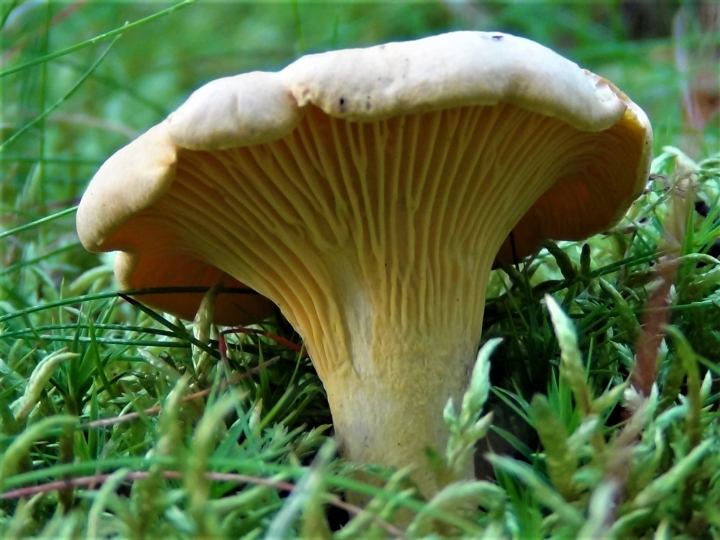















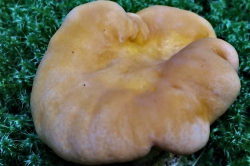
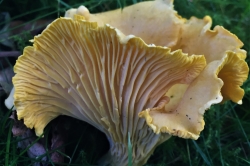
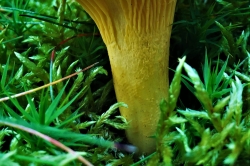
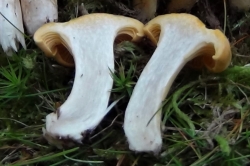
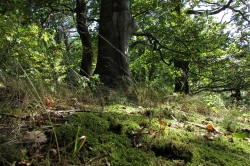
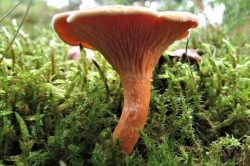




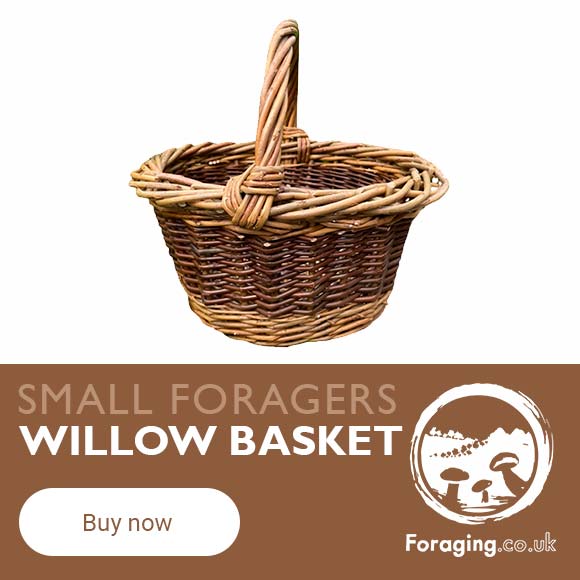

20 comments for Chanterelle
Marlow
What’s the time span of a chanterelle, finding a lot of small ones and leaving, how long should I wait ?
Hi Steve, small Chanterelles can grow into large ones in just a few days if the weather is right, warm and wet, but if it is dry they seem to not change much day to day. If you are lucky the season for them should last from about June to September. Eric.
Could I ask please…. Are the British Chanterelles different from the ones in Finland?
According to this page, I have been foraging the ‘False Chanterelles’ annually for 8+ years now (this is how long I’ve been visiting)
I might add that the entire population of Finland forage, buy and sell these ‘False Chanterelles’.
So genuinely interested to know.
There are many different chanterelle species but the false chanterelle is not a chanterelle and is toxic to some people although some can eat it with impunity.
Still no seeing chanterelles in Scotland yet (5/6/2020,would it be due to very warm and dry weather?,we’ve had rain here now though so that may help?
Same here in South East England. We’ve had a few days of rain now so we can but hope! Oysters now appearing and plenty of Chicken of the Woods.
Big clump by Hadlow in Kent by the footpath. I must get a snap when I return to flat but were very soggy after deluge.
Hi there…I have photos of a chanterelle (I think…) found in Dordogne, France…How can I post the photos, please.
thanks, Perry
You can send photos to [email protected]. Please include photos of the cap, stem, gills and a mushroom in situ.
Big clump by Hadlow in Kent by the footpath. I must get a snap when I return to flat but were very soggy after deluge.
Your vids are very helpful!
Almost certain these are chanterelles from North Lancashire, but are white in appearance, growing in small groups in pasture up to woodland. Understand chanterelles should be orangey in colour.
Chanterelles can fade to almost white but always be certain of your identification before consuming any wild food.
Excellent identifying video. Thank you……this year has been fantastic for chanterelles……I have had bags and bags of them.
Have you ever seen a folded in chanterelle , so it’s folded like a cabbage so just the gills are showing ?
Any mushrooms can mutate and I have seen almost inside out Chanterelles.
Hello wild food UK! Do you know if chanterelles will regrow on the same spot within the same season? Ie within weeks or months apart (assuming good weather conditions)
Thank you for the help!
Depending on the weather conditions, chanterelles can fruit twice or more in the same season. This year I found Chanterelles in July, the season then seemed to end but I’m now finding them again in November.
Thank you for your help 🙂
I bought some chanterelles at a little market near my house and ….sorry but….yuck! kind of bitterish….dirt earthy…….I’m definitely going to leave them for the forest creatures to eat 🙂 Lovely website. Best wishes to all from Harare, Zimbabwe